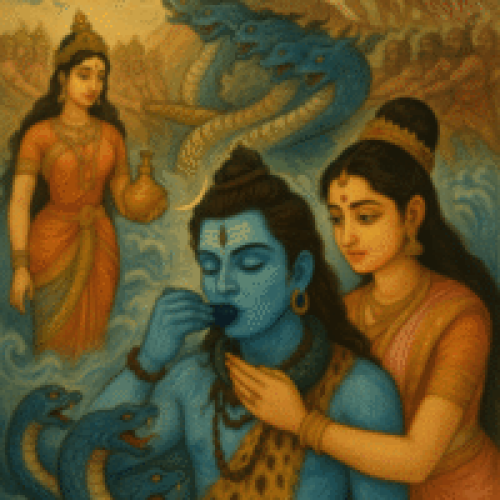Samudra Manthan: The Churning of the Ocean of Milk
Samudra Manthan, or The Churning of the Ocean of Milk, is one of the greatest and most symbolic legends found in Hindu scriptures, especially in the Bhagavata Purana, Vishnu Purana, and Mahabharata. This story represents the eternal struggle between good and evil, and the cosmic efforts needed to achieve balance, prosperity, and immortality.

🌊 Why did Samudra Manthan happen?
Once, the Devas (gods) lost their strength and wealth because of a curse by Sage Durvasa. Without their powers, they could not protect the universe. Worried, they went to Lord Vishnu, who advised them to churn the Kshira Sagar (Ocean of Milk) to bring out Amrit — the nectar that would restore their strength and make them immortal.
But the task was huge. Vishnu suggested that the Devas seek help from their rivals, the Asuras (demons), promising to share the nectar with them after the churning.
🔱 How was the ocean churned?
The churning of the ocean required great effort and powerful tools:
- Mount Mandara was used as the churning rod.
- Vasuki, the king of serpents, became the churning rope.
- The Devas held one end of Vasuki, and the Asuras held the other end.
As they pulled back and forth, Mount Mandara began to sink. Seeing this, Lord Vishnu took the form of Kurma (a giant tortoise) and held the mountain on his back to support it during the churning.
🌟 What emerged from the churning?
As the ocean was churned, many treasures and beings came out one by one:
✅ Kamadhenu – the wish-fulfilling divine cow
✅ Airavata – the white elephant, later the mount of Indra
✅ Uchhaishravas – the divine horse
✅ Kalpavriksha – the wish-fulfilling tree
✅ Apsaras – celestial maidens
✅ Chandra – the moon, which became an ornament of Lord Shiva
✅ Lakshmi Devi – goddess of wealth and prosperity, who chose Vishnu as her consort
✅ Kaustubha gem – the most valuable jewel, worn by Vishnu
But before Amrit appeared, something dangerous emerged…
☠ The emergence of Halahala poison
A terrible, dark poison called Halahala came out, threatening to destroy all of creation with its deadly fumes and heat. The Devas and Asuras were terrified.
They prayed to Lord Shiva, who out of compassion drank the poison to save the universe. Goddess Parvati stopped the poison in his throat, turning it blue. Thus Shiva became known as Neelkanth, the blue-throated one.
👑 The Amrit and Mohini’s cleverness
Finally, the Amrit — the nectar of immortality — rose from the ocean. But the Asuras snatched it and refused to share it with the Devas.
To protect the balance of the universe, Vishnu took the form of Mohini, a beautiful and enchanting woman. Mohini charmed the Asuras and cleverly distributed the nectar to the Devas, who regained their strength and defeated the Asuras.
One Asura, Rahu, disguised himself as a Deva and drank some nectar. But before it could pass his throat, Vishnu beheaded him. His head became Rahu, and his body became Ketu, celestial beings who cause eclipses.
🌸 The meaning of Samudra Manthan
Samudra Manthan is much more than a story. It teaches:
- 🌼 Teamwork is powerful, even between enemies, when the goal is greater than differences.
- 🌼 Greed leads to downfall, as seen with the Asuras.
- 🌼 Sacrifice saves the world, like Shiva’s act of drinking the poison.
- 🌼 Wisdom and strategy are mightier than brute force, shown by Mohini’s cleverness.
